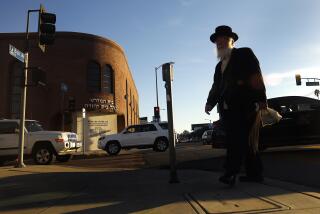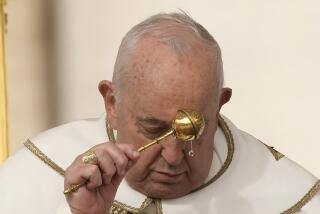For Some, It’s Easter Today : Eastern Orthodox Christians--30,000 Strong in O.C.--End Holy Week
- Share via
Holding a red-dyed Easter egg, Eve Tibbs, 40, will crack it against another held by a family member. “Christ is risen,” the Yorba Linda woman then will say. And her counterpart will answer, “Truly he is risen.”
The eggshell represents the tomb of Christ. The red color denotes his blood. And the yolk symbolizes his Resurrection.
This tradition is part of Easter Sunday celebrations for many of the tens of thousands of Orthodox Christians in Orange County.
Today marks the end of Holy Week observances, or Pascha, in the Eastern Orthodox Church. Orthodox Christians will have completed their 47-day fast of no meat and dairy products, and attend noon services and fellowship meals where roasted lamb will be served.
Although the Eastern Orthodox Church celebrates the same Easter week events as other Christian faiths, it bases its calculation for the end of Pascha--Passover in Hebrew--on the Julian Calendar. The Western church follows the Gregorian calendar.
“Orthodox Christians keep to the Julian calendar to be consistent with the New Testament,” explained Father George Stephanides of St. Paul’s Greek Orthodox Church in Irvine.
For Orthodox Christians, Easter comes after the conclusion of the Jewish Passover and follows the first full moon after the vernal equinox.
During the past week, called Holy Week, Orthodox Christians recalled the last days of Christ on Earth. The most prominent services began Friday with a procession of the holy sepulcher decorated with hundreds of flowers.
The liturgical high point came at midnight on Saturday when darkened church interiors were illuminated during a vigil to proclaim “Christ is Risen.”
On Saturday, the eve of Easter, tradition calls for the priest to hold a lit candle and announce, “Come receive the light.” The flame is then spread to candles held by parishioners. The congregation then traditionally files outside the church to symbolize the Christians’ missions to the world.
Noon services today represent the culmination of Holy Week observances.
“Sunday is our day of celebration,” Tibbs said last week. “We spend the earlier part of the week fasting and feeling Christ’s last days. By Sunday, we experience the joy he feels.”
At St. Paul’s today, Stephanides will deliver the Resurrection Gospel, which will be translated into eight other languages, including French, Greek, Russian, Romanian, Arabic, Spanish and Latin.
“Lay people will deliver the Gospel in other languages to show the universality of Jesus’ Resurrection,” Stephanides said.
And because Pascha usually follows the Western church’s Easter holiday, he said, this helps preserve the spiritual meaning behind the celebrations.
“We try to avoid whatever might be pagan or commercial. We get rid of the bunnies and we also get the bargains,” he joked.
Danita Barnard, a member of St. Paul’s and a resident of Fountain Valley, agreed. Although she does prepare Easter baskets for her daughter, Krystal, she sprinkles some candy around spiritual books.
“We try to teach her the value of the church instead of the Easter basket,” said Barnard, 31.
About 30,000 Orthodox Christians live in Orange County, where there are fewer than a dozen Orthodox churches. Nationwide, the church has about 10 million members, and worldwide about 400 million, Stephanides said.
The church believes in the Holy Trinity, the Bible, and salvation through the Resurrection of Jesus. The Eastern Orthodox ecclesiastical communion was formed when 15 Christian sects separated from the Roman Catholic church before the Reformation.
Stephanides said this Pascha marks the third year of freedom for the church, since the Berlin Wall fell and religious freedom came to Eastern Europe. Since 1453, when Constantinople (now Istanbul) fell to the Turks, various dioceses have been under either Ottoman rule or communism.
More to Read
Sign up for Essential California
The most important California stories and recommendations in your inbox every morning.
You may occasionally receive promotional content from the Los Angeles Times.













